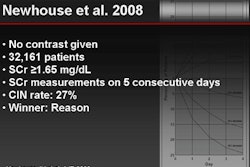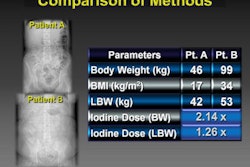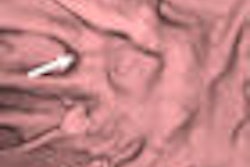A meta-analysis examining contrast agent safety in nearly 3,000 subjects found no evidence that a more expensive iso-osmolar agent resulted in fewer contrast-induced acute kidney injuries (CI-AKI) compared to cheaper low-osmolar alternatives, overall, although the iso-osmolar agent did improve safety versus some individual low-osmolar agents.
Dr. Michael Reed and colleagues from the University of Michigan in Ann Arbor and the University of Miami in Florida searched multiple databases to find 16 randomized, controlled trials comparing the incidence of CI-AKI with the iso-osmolar agent iodixanol (Visipaque, GE Healthcare, Chalfont St. Giles, U.K.) or low-osmolar contrast media (LOCM).
"A prior meta-analysis suggested that iodixanol ... was associated with less CI-AKI than LOCM, but this study was limited by ascertainment bias and did not include the most recent randomized, controlled trials," they wrote in the July issue of JACC: Cardiovascular Interventions (2009, Vol. 2:7, pp. 645-654).
The study used random-effects models to calculate summary risk ratios (RR) for CI-AKI, need for hemodialysis, and death. The primary end point for the analysis was the incidence of CI-AKI as defined by each individual study protocol.
Although there was a trend toward a reduced relative risk of CI-AKI with iodixanol compared to LOCM as a whole, the difference was not statistically significant, the authors reported.
Kidney injury occurred in 128 of 1,379 (9.3%) patients who received iodixanol versus 158 of 1,375 (11.5%) patients who received LOCM. There was no significant difference in the incidence of CI-AKI in the iodixanol group versus the LOCM group overall (summary RR, 0.79; 95% confidence interval [CI]: 0.56 to 1.12; p = 0.19).
Looking at individual contrast agents, iodixanol offered a comparative safety advantage vis-à-vis ioxaglate (Hexabrix, Guerbet, Roissy, France) (RR, 0.58; 95% CI: 0.37 to 0.92; p = 0.022) and iohexol (Omnipaque, GE Healthcare) (RR, 0.19; 95% CI: 0.07 to 0.56; p = 0.002).
However, no safety difference was found when compared with iopamidol (Isovue, Bracco Diagnostics, Princeton, NJ) (RR, 1.20; 95% CI: 0.66 to 2.18; p = 0.55), iopromide (Ultravist, Bayer HealthCare Pharmaceuticals, Wayne, NJ) (RR, 0.93; 95% CI: 0.47 to 1.85; p = 0.84), or ioversol (Optiray, Covidien Imaging Solutions, Hazelwood, MO (RR, 0.92; 95% CI: 0.60 to 1.39; p = 0.68).
No significant differences were found in the rates of postprocedural hemodialysis or death. The results suggest that "iodixanol, when compared with LOCM overall, is not associated with less CI-AKI," Reed and colleagues wrote, adding that the relative renal safety of LOCM agents compared with iodixanol "may vary based on the specific type of LOCM."
Related Reading
CT angiography unrelated to acute nephropathy, July 27, 2009
Contrast-induced nephropathy: Much ado about nothing? July 28, 2009
Acute kidney injury raises risk of long-term adverse outcomes, July 17, 2009
Study confirms link between angio contrast and long-term kidney damage, June 25, 2009
Sodium bicarbonate helps avoid contrast nephropathy, June 5, 2009
Copyright © 2009 AuntMinnie.com



















